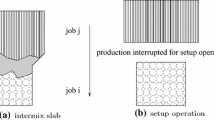Abstract
Production planning and scheduling in steelmaking-continuous casting (SCC) process consists of decision making about three important issues: consolidating orders into charges, grouping charges into casts, and scheduling the casts on machines. In contrast to earlier investigations that mostly focus on one of these issues, a comprehensive two-phase approach is presented in this paper in order to solve the whole problem. In the first phase, a continuous-time formulation is developed to determine what casts in what sequences should be scheduled on which machines. The solution obtained is then used as an optimal framework to create the final schedule in the second phase where the assignment rules embedded in a heuristic algorithm are used to consolidate orders into charges and group charges into casts. This method has been successfully used for Mobarakeh Steel Company (MSC), the biggest steel enterprise in the Middle East. Computational experiments demonstrate that the proposed method substantially increases the productivity in MSC.
Similar content being viewed by others
References
Tang L, Wang G, Liu J, Liu J (2011) A combination of Lagrangian relaxation and column generation for order batching in steelmaking and continuous casting production. Naval Res Logist (NRL) 58(4):370–388
Lee HS, Murthy SS, Haider SW, Morse DV (1996) Primary production scheduling at steelmaking industries. IBM J Res Dev 40(2):231–252
Dawande M, Kalagnanam J, Lee HS, Reddy C, Siegel S, Trumbo M (2004) The slab-design problem in the steel industry. Interfaces 34(3):215–225
Kalagnanam JR, Dawande MW, Trumbo M, Lee HS (2000) The surplus inventory matching problem in the process industry. Oper Res 48(4):505–516
Tang L, Wang G, Chen Z-L (2014) Integrated charge batching and casting width selection at Baosteel. Oper Res 62(4):772–787
Chang SY, Chang M-R, Hong Y (2000) A lot grouping algorithm for a continuous slab caster in an integrated steel mill. Prod Plan Control 11(4):363–368
Tang L, Wang G (2008) Decision support system for the batching problems of steelmaking and continuous-casting production. Omega 36(6):976–991
Pacciarelli D, Pranzo M (2004) Production scheduling in a steelmaking-continuous casting plant. Comput Chem Eng 28(12):2823–2835
Atighehchian A, Bijari M, Tarkesh H (2009) A novel hybrid algorithm for scheduling steel-making continuous casting production. Comput Oper Res 36(8):2450–2461
Bellabdaoui A, Teghem J (2006) A mixed-integer linear programming model for the continuous casting planning. Int J Prod Econ 104(2):260–270
Missbauer H, Hauber W, Stadler W (2009) A scheduling system for the steelmaking-continuous casting process. A case study from the steel-making industry. Int J Prod Res 47(15):4147–4172
Tang L, Zhao Y, Liu J (2014) An improved differential evolution algorithm for practical dynamic scheduling in steelmaking-continuous casting production. 18:209-225
Ouelhadj D, Cowling PI, Petrovic S (2003) Utility and stability measures for agent-based dynamic scheduling of steel continuous casting. In: Robotics and automation. Proceedings. ICRA'03. IEEE International Conference on, 2003. IEEE, pp 175-180
Tang L, Wang X, Liu J (2008) Color-coating production scheduling for coils in inventory in steel industry. Automation Science and Engineering, IEEE Transactions on 5 (3):544-549
Cowling P (2003) A flexible decision support system for steel hot rolling mill scheduling. Comput Ind Eng 45(2):307–321
Lopez L, Carter MW, Gendreau M (1998) The hot strip mill production scheduling problem: a tabu search approach. Eur J Oper Res 106(2):317–335
Höhn W, König FG, Möhring RH, Lübbecke ME (2011) Integrated sequencing and scheduling in coil coating. Manag Sci 57(4):647–666
Ebadi A, Moslehi G (2012) Mathematical models for preemptive shop scheduling problems. Comput Oper Res 39(7):1605–1614
Ganesan T, Elamvazuthi I, Shaari KZK, Vasant P (2013) An algorithmic framework for multiobjective optimization. Sci World J 2013
Ganesan T, Elamvazuthi I, Shaari KZK, Vasant P (2013) Multiobjective optimization of green sand mould system using chaotic differential evolution. Paper presented at the Transactions on Computational Science XXI
Ganesan T, Elamvazuthi I, Shaari KZK, Vasant P (2013) Swarm intelligence and gravitational search algorithm for multi-objective optimization of synthesis gas production. Appl Energy 103:368–374
Ganesan T, Elamvazuthi I, Shaari KZK, Vasant P (2014) Multiobjective optimization of bioethanol production via hydrolysis using hopfield-enhanced differential evolution. Contemporary advancements in information technology development in dynamic environments:340-359
Ganesan T, Elamvazuthi I, Zilati Ku Shaari K, Vasant P (2014) Hopfield differential evolution for multi-objective optimization of a cement-bonded sand mould system. Int J Manag Sci Eng Manag 9(1):40–47
Jiménez F, Sánchez G, Vasant P (2013) A multi-objective evolutionary approach for fuzzy optimization in production planning. J Intell Fuzzy Syst 25(2):441–455
Baptiste P, Le Pape C, Nuijten W (2001) Constraint-based scheduling: applying constraint programming to scheduling problems, vol 39. Springer
Pinedo ML (2012) Scheduling: theory, algorithms, and systems. Springer Science & Business Media, New York
Elamvazuthi I, Vasant P, Ganesan T (2013) Hybrid optimization techniques for optimization in a fuzzy environment. Intell Syst Ref Libr 38:1025–1046
Vasant P (2013) Hybrid mesh adaptive direct search genetic algorithms and line search approaches for fuzzy optimization problems in production planning. Intell Syst Ref Libr 38:779–799
Vasant P (2014) Hybrid line search and simulated annealing for production planning system in industrial engineering. Int J Manuf Mater Mech Eng (IJMMME) 4(2):1–13
Author information
Authors and Affiliations
Corresponding author
Rights and permissions
About this article
Cite this article
Yadollahpour, M.R., ArbabShirani, B. A comprehensive solution for continuous casting production planning and scheduling. Int J Adv Manuf Technol 82, 211–226 (2016). https://doi.org/10.1007/s00170-015-7314-9
Received:
Accepted:
Published:
Issue Date:
DOI: https://doi.org/10.1007/s00170-015-7314-9




